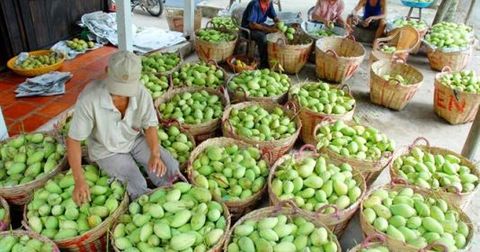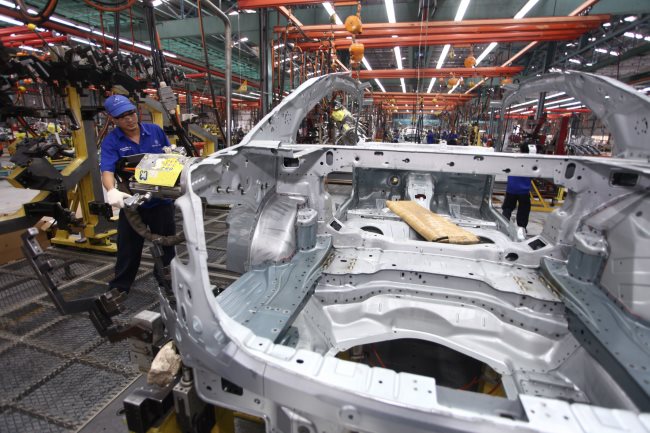In Quang Tri Province, switching to solar energy is a matter of course
In Quang Tri Province, switching to solar energy is a matter of course
Hundreds of photovoltaic panels glow with a pale blue light at sunset, spread over a vast area which a year ago was wasteland.
The LIG Solar Power Plant is the first of its kind in Quang Tri.
For a province long associated with the devastation of war and severely hit by the disaster caused by Taiwan-invested Hung Nghiep Formosa Ha Tinh Steel Co Ltd in 2016, the switch to sustainable energy and a green economy is inevitable.
It took less than eight months to realise a VND1.2 trillion (US$51.6 million) project – from a plan on paper to part of the national power grid in late May 2019.
The potential of renewable energy, including wind and solar power, has been a focus for Quang Tri Province and formulated into a long-term strategy for sustainable development. This industry is designed to work alongside organic agriculture and fishery.
“The LIG Solar Power Plant, with a capacity of 49.5MW, invested by Licogi 13 Joint Stock Company, was implemented in Gio Linh District’s communes of Gio Thanh and Gio Hai in late 2018 and started commercially generating electricity on May 22, 2019,” Ha Sy Dong, deputy head of the provincial People’s Committee told Viet Nam News.
“It was granted incentives in terms of corporate income tax, import tax, land lease and other support,” he added.
According to Quoc Ho Hiep Nghia, deputy director of Quang Tri Province Department of Industry and Trade, the sandy, coastal area where the plant is located is infertile, making land clearance much easier.
“Land compensation and administrative procedures were all transparent to gain local residents’ approval, ensuring the plant would come into operation before June to enjoy favourable price regulated by the Government decision no.11,” said Nghia.
Under the document, which took effect from June 1, 2017 to June 1, 2019, all output produced by solar power plants would be purchased at US9.3 cents per kWh – a profitable rate for investors.
“Since its first months were some of the sunniest in Quang Tri Province, the plant operated at full capacity. The company has proposed to expand the project in other localities,” he said.
Vision
Despite still being slow in attracting investment, Quang Tri Province has showed efforts in enhancing proactive leadership as well as business support services in the period from 2014 to 2018, rising 1.22 and 0.35 points, respectively, according to the 2018 Provincial Competitiveness Index (PCI) report by Viet Nam Chamber of Commerce and Industry in March, 2019.
These improvements along with a comparatively rich resource of solar irradiance – some 1,800 sunshine hours per year – have encouraged investors to fund energy projects in the province.
At present, two other solar energy power projects called Gio Thanh 1 and Gio Thanh 2, with total capacity of 100MW, are underway in Gio Linh District.
3,000 panels pning an area of 124.8ha, once completed, will provide 130 million kWh of electricity per year for the national power grid, helping to reduce 105 tonnes of carbon dioxide annually.
Six other projects, including one floating solar farm, which are expected to generate 550MW of electricity per year, have been proposed to Ministry of Industry and Trade (MoIT).
One megawatt peak (MWp) is expected to contribute from VND350 to 500 million ($15,050 to 21,500) to the local budget.
“A solar energy farm occupies a large area, from 1 to 1.2ha. Therefore, we are eager to develop the industry over infertile land. Water-based projects are also prioritised as they help to operate irrigation systems and, at the same time, produce sustainable energy,” said Nghia.
Challenges and adaptation
The MoIT in mid-June filed to the Government a plan on feed-in tariffs (FiT) for solar energy projects based on the irradiance zonal classification of provinces and cities into two different zones.
Under the plan, the FiT rates fluctuate from 6.67 to 7.89 cents per kWh for a group of six provinces with high solar irradiance, called Zone 2, including Ninh Thuan, Binh Thuan, Khanh Hoa, Dak Lak, Gia Lai and Phu Yen.
The remaining 57 provinces and cities with lower solar irradiance known as Zone 1 will enjoy the tariff rates between 7.09 and 8.38 cents depending on solar technologies.
Quang Tri Province has also asked MoIT to name it in Zone 2, regarding its high potential – about 4.5kWh generated per one square metre of solar panel – as well as difficulties in calling for investment, Nghia said.
The power transmission infrastructure, one of the biggest challenges for solar energy projects, is also on the table.
The major 110kv transmission line connecting the provincial capital Dong Ha and border town Lao Bao – Viet Nam’s gateway on the East-West Economic Corridor – is being overloaded.
Local authorities have worked with the MoIT, Viet Nam Electricity (EVN) and related agencies to push the upgrading process of Lao Bao Substation by mid-2021, compared to 2024 in the initial plan.
A new power transmission system project with a 250kw substation will be deployed in the period between 2024 and 2030.
The preparation has been completed, however, Quang Tri Province and its solar energy investors have been still waiting for the Government’s new pricing decision.
The document, which will replace Decision No. 11, was expected to be issued in mid-September yet has remained unrevealed by now.
“We are supporting investors in surveying and planning when waiting for the new prices. With suitable prices, I believe solar energy projects, along with other renewable energy plants, in Quang Tri will thrive,” said Nghia.

















